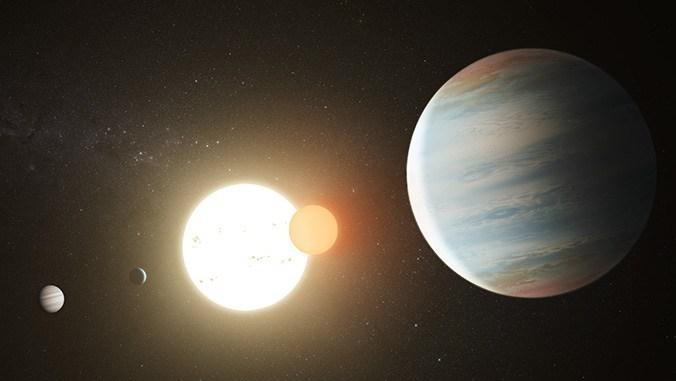UH Astronomer’s Planet Prediction Verified in Star Wars-Like System
A group of astronomers, including Nader Haghighipour from the Institute for Astronomy at the University of Hawaiʻi at Mānoa, discovered a third planet in the circumbinary planetary system Kepler-47.

Artist rendition of the Kepler-47 circumbinary planet system with its three planets.PC: NASA/JPL-Caltech/T. Pyle
This discovery cements the system’s title as the most interesting of the binary-star worlds, and marks the first complete and dynamically full planetary system around a binary star. A complete and dynamically full planetary system is one that cannot have any more planets—like our solar system. Circumbinary planets are those that orbit both stars of a binary star system, like Tatooine in the Star Wars films.
“In 2015, we predicted the existence of a third planet in this system on dynamical grounds. It is great to see reality matches our prediction,” said Haghighipour.
With its three planets orbiting two stars, Kepler-47 is the only known multi-planet circumbinary system. The orbit of the outer planet of this system falls well within the binary’s habitable zone, the region where an Earth-like planet could maintain liquid water on its surface.
Planet detected through transit method
The planets in the Kepler-47 system were detected via the transit method. This method relies on small decreases in the measured brightness of a star (or, in this case, a pair of stars), when a planet passes in front of the star as seen from Earth. The newly discovered planet, dubbed Kepler-47d, was not detected earlier because its distance from its host stars means it produces only a tiny transit signal.
“We saw a hint of a third planet back in 2012, but with only one transit we needed more data to be sure,” said San Diego State University astronomer Jerome Orosz, the paper’s lead author. “With an additional transit, the planet’s orbital period could be determined, and we were then able to uncover more transits that were hidden in the noise in the earlier data.”
As is common with circumbinary planets, the alignment of the orbital planes of the planets changes with time. In this case, the middle planet’s orbit was not aligned during the first two years of operation of the Kepler Space Telescope. In 2012, astronomers saw a hint of the existence of a third planet in the data. As the orbit of the third planet became more aligned, stronger transit signals were detected, and the transits went from undetectable at the beginning of the Kepler Mission to the deepest of the three planets over the span of just four years.
“The discovery of Kepler-47d confirms two of our predictions—first, that planets form around binary stars the same way they form around single stars, and second, that they too can form complete systems,” says Haghighipour, who has developed theories of planet formation and habitability in circumbinary orbits.
Planetary system details
The inner, middle and outer planets of Kepler-47 system are 3.1, 7.0, and 4.7 times the size of the Earth, and take 49, 187, and 303 days, respectively, to orbit around the central binary. The stars themselves orbit each other in only 7.45 days. One star is similar to the Sun, while the other has only one-third of the Sun’s mass. The researchers were surprised by both the size and location of the new planet. Kepler-47d is the largest of the three planets in the Kepler-47 system.
The Kepler-47 planetary system is an example of the diversity of solar systems outside our own. Despite having two “suns”, the entire system is so compact that it would fit inside the orbit of Earth. It is approximately 3,340 light-years away in the direction of the constellation Cygnus.
“This work builds on one of the Kepler’s most interesting discoveries: that systems of closely-packed, low density planets are extremely common in our galaxy,” said University of California, Santa Cruz astronomer, Jonathan Fortney, who was not part of the study.
This research has been published in the Astronomical Journal, volume 157, issue 5, article 174.








